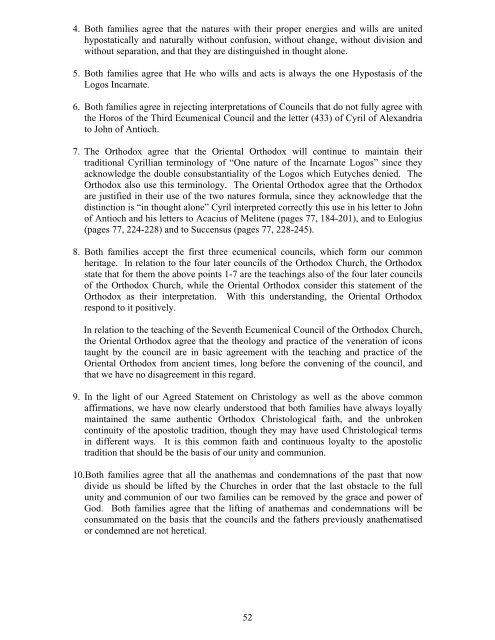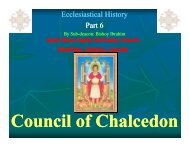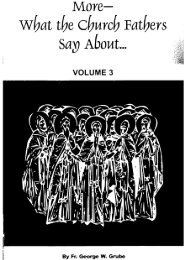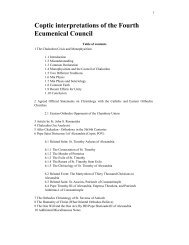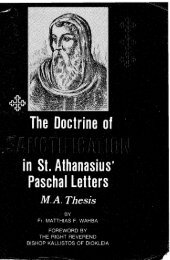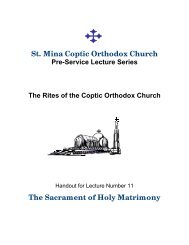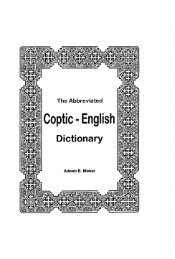Coptic Church & Ecumenical Movement - Saint Mina Coptic ...
Coptic Church & Ecumenical Movement - Saint Mina Coptic ...
Coptic Church & Ecumenical Movement - Saint Mina Coptic ...
You also want an ePaper? Increase the reach of your titles
YUMPU automatically turns print PDFs into web optimized ePapers that Google loves.
4. Both families agree that the natures with their proper energies and wills are united<br />
hypostatically and naturally without confusion, without change, without division and<br />
without separation, and that they are distinguished in thought alone.<br />
5. Both families agree that He who wills and acts is always the one Hypostasis of the<br />
Logos Incarnate.<br />
6. Both families agree in rejecting interpretations of Councils that do not fully agree with<br />
the Horos of the Third <strong>Ecumenical</strong> Council and the letter (433) of Cyril of Alexandria<br />
to John of Antioch.<br />
7. The Orthodox agree that the Oriental Orthodox will continue to maintain their<br />
traditional Cyrillian terminology of “One nature of the Incarnate Logos” since they<br />
acknowledge the double consubstantiality of the Logos which Eutyches denied. The<br />
Orthodox also use this terminology. The Oriental Orthodox agree that the Orthodox<br />
are justified in their use of the two natures formula, since they acknowledge that the<br />
distinction is “in thought alone” Cyril interpreted correctly this use in his letter to John<br />
of Antioch and his letters to Acacius of Melitene (pages 77, 184-201), and to Eulogius<br />
(pages 77, 224-228) and to Succensus (pages 77, 228-245).<br />
8. Both families accept the first three ecumenical councils, which form our common<br />
heritage. In relation to the four later councils of the Orthodox <strong>Church</strong>, the Orthodox<br />
state that for them the above points 1-7 are the teachings also of the four later councils<br />
of the Orthodox <strong>Church</strong>, while the Oriental Orthodox consider this statement of the<br />
Orthodox as their interpretation. With this understanding, the Oriental Orthodox<br />
respond to it positively.<br />
In relation to the teaching of the Seventh <strong>Ecumenical</strong> Council of the Orthodox <strong>Church</strong>,<br />
the Oriental Orthodox agree that the theology and practice of the veneration of icons<br />
taught by the council are in basic agreement with the teaching and practice of the<br />
Oriental Orthodox from ancient times, long before the convening of the council, and<br />
that we have no disagreement in this regard.<br />
9. In the light of our Agreed Statement on Christology as well as the above common<br />
affirmations, we have now clearly understood that both families have always loyally<br />
maintained the same authentic Orthodox Christological faith, and the unbroken<br />
continuity of the apostolic tradition, though they may have used Christological terms<br />
in different ways. It is this common faith and continuous loyalty to the apostolic<br />
tradition that should be the basis of our unity and communion.<br />
10.Both families agree that all the anathemas and condemnations of the past that now<br />
divide us should be lifted by the <strong>Church</strong>es in order that the last obstacle to the full<br />
unity and communion of our two families can be removed by the grace and power of<br />
God. Both families agree that the lifting of anathemas and condemnations will be<br />
consummated on the basis that the councils and the fathers previously anathematised<br />
or condemned are not heretical.<br />
52


